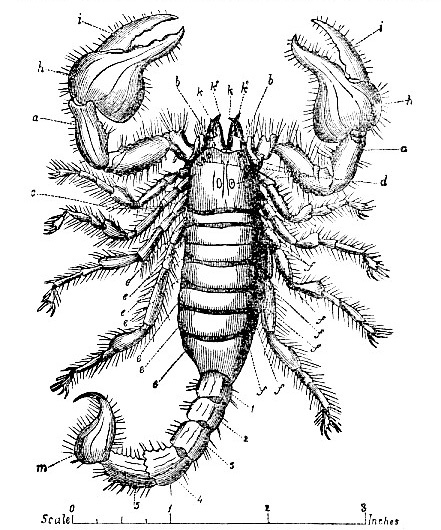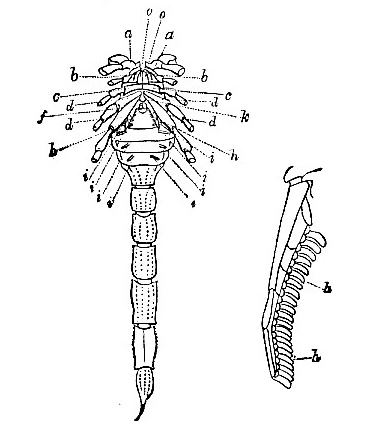1902 Encyclopedia > Arachnida > Arachnida - Order V: Scorpionidea - Sub-Order II: Scorpiones - External Structure
Arachnida
(Part 17)
(17) ARACHNIDA - ORDER V: SCORPIONIDEA - SUB-ORDER II: SCORPIONES - EXTERNAL STRUCTURE
Between the solpugids and the scorpions (figs. 19, 20) the last group (Pseudo-Scorpiones) gives us an evident connecting link.

Fig. 19 -- Scorpion (Buthus heros, Koch). a, a, palpi, of which h, h, are the digital or fourth joints and i, i, the movable fingers; b, b, falces, with two movable fangs k, k, and two fixed ones k*, k*; d, eyes; e...e, upper segmental plates of abdomen; f...f, articulated cartilaginous membrane, connecting upper and under plates of abdomen; m, bulbous sting.

Fig. 20 -- Scorpio Amoreuxii, Sav., under side, with legs, palpi, and falces truncated. a, a, maxillae; b, b, supernumerary or second pair of maxillae, supporting the first pair of legs; c, c, third pair of ditto supporting second pair of legs; d...d, basal joints of two hinder pairs of legs; f, orifice of sexual organs; h, h, comb-like appendages (also figured separately, enlarged); i...i, eight spiracies leading to breathing organs; k, rudimentary sternal plate; o, o, portion of third pair of supernumerary maxillae acting as a sternal labium.
In the present sub-order, Scorpionidea, or true scorpions, the EXTERNAL STRUCTURE consists of a more or less elongated-oval body, covered with a coriaceous, or hard and horny integument. The cephalo-thorax is tuberculate or granulose, and marked with various seams, or grooves, and ridges, no doubt indicating the union of the caput and thoracic segments. One longitudinal, and, in general, strongly marked groove always divides the caput longitudinally, dividing also the tubercle on which the central pair of eyes is placed. This groove possibly represents the union of the two segments of a kind of duplex caput analogous to the duplex generative system noted postea (p. 285). The abdomen is sessile, i.e., united to the thorax throughout its whole breadth, and composed of twelve segments, of which the five posterior ones form a tail; these latter are segments in the strictest sense, while those of the abdomen proper are, more correctly speaking, articulations covered above and below with transverse horny plates. Articulated to the fifth joint of the tail is a bulb terminating with a sharp curved sting. Poison secreted in the bulb is injected into wounds through two minutes perforations near the extremity of the sting. The legs are not very robust, nor long, nor very unequal in length; each consists of seven joints, of which the basal ones (coxae) are fixed to the under side of the cephalo-thorax, and act partly as a sternum; the only portion which can be said to represent a real sternal plate being a very small sub-triangular, or in some genera, quadrangular piece immediately behind the first segment of the abdomen between the extremities of the coxae of the fourth pair of legs (figs. 20, k). These latter are soldered to those of the third pair, the junction being visible as a more or less distinct groove. The coxae of the first and second pairs have angular pieces attached to them, used in manducation, and hence called supernumerary maxillae (fig. 20,o,o,b,b); but while the pieces of the first pair might perhaps be so named, those of the second pair, closing together as they do on their inner margins, rather form a kind of sub-triangular sternal appendage representing the labium, of which there is none properly so-called. Each tarsus ends with two rather long curved superior, and one short straight tooth-like inferior, claws. The first and second segments of the abdomen underneath are almost rudimentary; between them and the anterior edge of the first segment is situated the external aperture to the organs of generation, the horny plate protecting it being divided longitudinally by a more or less distinct groove. From the second segment, and articulated to it, spring two very conspicuous, curious, comb-like appendages (fig. 20, h,h), composed of a longitudinal shaft of several distinct joints, with a number of slightly curved, bluntish tooth-like processes, fitting closely together, and articulated to their hinder edge, nearly at right angles, like the teeth of a comb. The shafts and teeth of these appendages vary in the details of their form and structure; their use has not yet been certainly ascertained, but their position points to some connection with the process of generation, which is also the opinion of L. Dufour and others; while they have also been thought to be intended to brush away obstructions from the spiracular orifices and other parts; but as in no case are they long enough to reach more than the first pair (out of four) of these orifices, and every consideration of structure is against their being used to clean other parts, this conjectured use is scarcely probable. The spiracular orifices are situated on the under side of the abdomen in four pairs - one pair in a transverse line on each of the third, fourth, fifth, and sixth segmental plates, and are in general easily seen.
The eyes (six, eight, ten, or twelve in number) are placed on the fore part and upper side of the cephalo-thorax,- two, generally large ones, in a transverse line near the middle of the upper part of the caput, the rest (much smaller and varying in size in different genera and species) in two symmetrical groups, one on each side near its fore corners. The falces form, as in other Arachnids, the upper side of the mouth; they are strong, cylindrical, and didactyle, the outer jaw-like terminal claw being articulated in opposition to the inner one; both are toothed, the denticulations varying in number, size, form. Below the falces (and forming with the before-mentioned coxal appendages a complete lower boundary to the mouth) are two strong maxillae, from each of which (as a basal joint) springs a long strong palpus of four joints, the last (digital) joint being more or less bulbiform at its base and didactyle at its extremity. The outer claw is movable, and (like the fixed one) serrate or denticulate on its inner edge. The size and form of this didactyle joint vary in different species and genera; in some it is of enormous size, and its denticulations very strong, while in others it is scarcely larger than the joint which precedes it. It is the possession, the position, and the office of the exact counterpart of this palpus, which, apart from other considerations, so plainly stamp the affinity of the two sub-orders of the Scorpionidea in spite of the differences of their respective internal anatomy. Within the mouth parts above noted is a pointed tongue (languette) tipped with hairs.
Read the rest of this article:
Arachnida - Table of Contents
|

